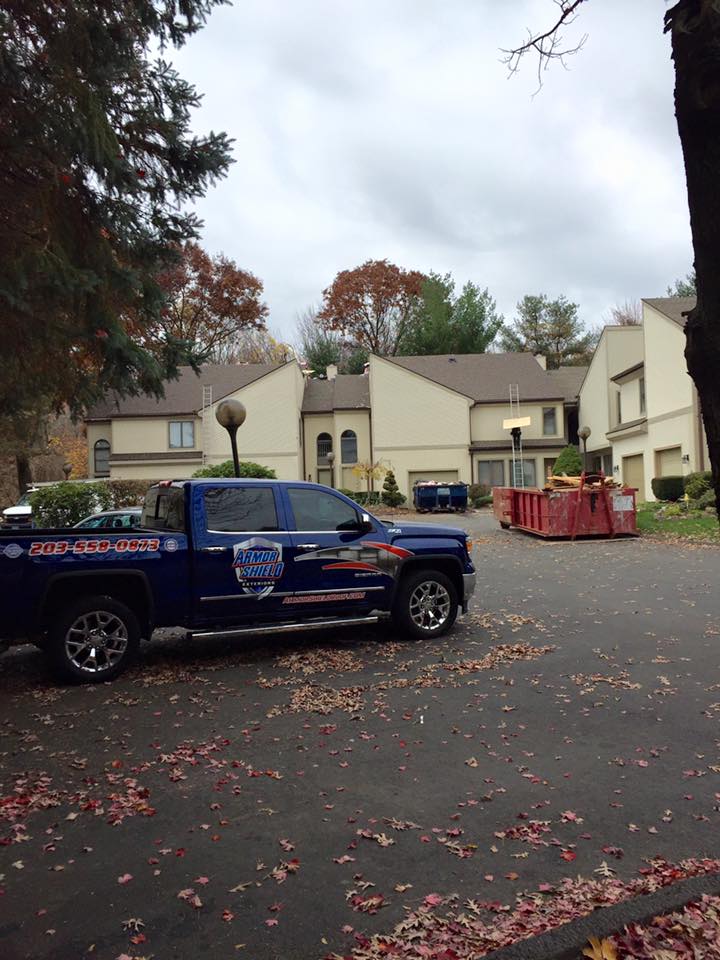HOW DOES A ROOF LEAK HAPPEN?
Customers Love Us, Roof Leaks Fear Us! Call 1-203-527-5338
Roof Leak Repair & Detection in Watertown, Oakville, Waterbury & Naugatuck
We provide expert roofing restorations after storm damage
Have a leaky roof? Get help today by calling 1-203-527-5338. Storm damage may qualify you for an insurance claim.
How Does a Roof Leak Happen?
Storm Damage - one or two rough storms may be manageable, but over the years extreme weather events will take its toll on your roof; checking for damage after each storm season can help you identify damaged areas needing attention
Heavy Rains - no matter how well weather-proofed your roof may be, constant heavy rains can slowly erode caulking, rust flashing, and soak into depressed areas, such as where nails have been hammered
Wind Damage - consistent gale-force winds, even when considered non-severe (between 39 to 54 miles per hour) can rip loosened shingles off the rooftop, while storm winds (from 55 to 63 miles per hour) can cause structural damage to your roof
Age - time will take its toll, whether we are human or roofs; for roofs, a 20- to 30-year lifespan is considered standard, so if your roof is passing its teen years, start planning on replacing it
Debris - because the roof surface is beyond our range of view, it's easy to forget to regularly inspect the roof, particularly after heavy winds or rains; any debris discovered during your inspection should be removed, which will extend the life of your roof
Clogged Gutters - while they are great for redirecting water flow off your roof, gutters are also popular collectors of dirt, leaves, twigs, and other small debris which can clog them; keeping them clean will go far to reducing leak problems near gutter junctions
Installation Holes - installing cables and antennas on the roof are great for reception and removing clutter from ground level, but those holes can lead to larger problems, especially after installed equipment is removed; be sure to plug and seal any roof holes before they become larger roofing issues
Missing Shingles - there are lots of ways in which shingles can fly off the roof, with wind damage (as mentioned above) being the most common culprit;
Flashing - metal flashing is great for sealing roof transitions, such as where the chimney comes out, where the roof joins a dormer, and around skylight edges; flashing sections can even move out of place because of missing nails or dried out and crack caulking.
Foot Traffic - a lot of roof damage occurs simply by homeowners walking on it while performing "inspections" after a storm or between seasons; as much as possible, leave all rooftop walking to professional roofers who know where it's safe to walk and avoid spots where damage can occur
How to Repair or Stop a Roof Leak
Repair Tip #1: Fix Asphalt Shingles
Curled Shingles - can be straightened and reattached with a caulking gun; in warmer weather, you will find the shingles more flexible than cold seasons (a good cold season tip is to warm up those shingles with a hair dryer to let them bender easier)
Cracked Shingles - can be repaired by using roof sealant under the crack, followed by applying the sealant to the top of the crack; use a putty knife to spread it over the edges of the cracked shingle
Missing/Broken Shingles - remove any of the remaining shingle materials from the roof, scrape the area clean, then slide and secure the new shingle into place
Repair Tip #2: Replace Damaged Wood Shakes
Repair Tip #3: Seal Leaky Joints
Does Homeowner's Insurance Cover Roof Leaks in Connecticut?
What Is the Cost of a Roof Leak Repair?
Knowing When to Call a Contractor
Have a leak coming from your roof and want a permanent solution? Call Armor Shield today at 1-203-527-5338 and schedule your free inspection!
WHAT MAKES US THE TOP 1 PERCENT?
Licensed, Insured and Experienced. GUARANTEED.
We are an Owens Corning Platinum Preffered Contractor
Over 45 5-Star Reviews On Google
We Help With Roof Insurance Claims!
HAAG Certified Roof Inspector
50 Year Roofing Platinum Protection Limited Warranty
Licensed, Insured and Experienced. GUARANTEED.
Owens Corning Platinum Preferred Contractor
HAAG Certified Roof Inspector
Over 100 Positive Reviews on Google
Roof Insurance Claims Assistance
50-Year Roofing Platinum Protection Limited Warranty
TAKE IT FROM OUR CUSTOMERS!

"Great experience from start to finish with the whole Armor Shield team. Neil was extremely knowledgeable and was there to answer any questions. Crew arrived on scheduled date and time, project was completed in one day. Awesome Job !"
- Pete C.
Button
"Awesome job from beginning to end! The salesperson, Tyler, was knowledgeable and prompt. The work was scheduled within 10 days. They showed up on time, stripped the whole house and garage and completed the job in one day. Everything was cleaned up. Looks great."
Barbara W.
Button
"We recently had our roof and gutters done by Armor Shield and I cannot say enough great things about them. As far as professionalism, cleanliness and quality they were excellent. I would highly recommend Neil and his team for anyone in need of a new roof."
Heidi F.
Button
SCHEDULE A FREE ROOF INSPECTION
Fill in your information below to get in touch with an Armor Shield Companies roofing professional. We typically respond to most inquiries the same day. Additionally, you can call us at 203-527-5338
We will get back to you as soon as possible
Please try again later
QUICK LINKS
POPULAR SERVICES
LOCAL OFFICE DETAILS
Armor Shield Exteriors | CT Roof Replacement Contractors & Residential Roofers
15 Falls Ave
Oakville, CT 06779
Contractor ID: HIC0639402
© 2020 Copyright All Rights Reserved Privacy Policy | Terms of Use | Disclaimer | Web Accessibility Statement . Armorshield Companies is an independent contractor and is not an affiliate of Owens Corning Roofing. THE PINK PANTHERâ„¢ & © 1964-2016 Metro-Goldwyn-Mayer Studios Inc. All Rights Reserved.
All Rights Reserved | Armor Shield Exteriors LLC









